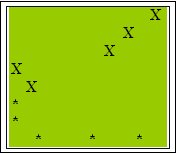COLLECTIVE SPORTS
UNIT: RUGBY
LESSON: 2
Aim:
IMPROVEMENT OF EXISTING SKILLS INTRODUCTION TO RUNNING SKILLS
APPARATUS: Rugby balls, cones/markers, stopwatch
ORGANISATION
CONTENT
TEACHING POINTS
Number of players:
9 in teams of 3. So 3 teams of 3 players.
A playing area may be marked with cones or markers.
WARM UP: ball familiarisation
1-Triples
There are three teams; two of them playing -the attackers (they have the ball) and the defenders (they have to intercept the ball)-, and the other team waiting. One of the pupils of the waiting team can be the timekeeper.
The attackers keep playing for 60 seconds, passing the ball to each other as many times as possible without defenders gaining the ball. This is the aim of the game. Players can run with the ball, but defenders must not tackle or grab attackers. So, they have to follow the no contact rule when playing.
If defenders intercept the ball, the attackers have to start to count the passes again.
After 60 seconds, the defenders are attackers, the attackers the waiting team and the waiting team the defenders.
Play the game at least 3 times in order that the 3 teams have the chance to be attackers and defenders.
Changes to the game:
- If players are good at passing and avoiding defenders, increase number of players.
- Match younger players with players of similar age and ability.
- Change size of playing area according to ability of players:
Bigger space helps attackers to pass.
Smaller space helps defenders.
- After 60 seconds, if defenders have touched or got hold of ball, attackers must deduct 3 passes from their highest total. Change over and play to same rule, and see who scored highest number of passes.
Easier: Play 3 v 1 or 3 v 2.
In grids, in groups of three, 1 ball to each 3.

MAIN PART:
skill; running
2- Side Steps
Children are divided in groups of 3: 1, 2 and 3. Nº 1 runs with the ball as if to score by placing the ball on the ground over the line AB. Nº 3 (defender) tries to tackle nº 1 by placing 2 hands on hips. Nº 1 side steps and cuts inside defender (nº 3) as he/she tries to cut off nº 1.
- To score, the ball must be placed on ground with downward pressure over line AB.
- Defender (nº 3) tackles by placing BOTH hands on attacker's hips.
- Nº 1 (attacker) attempts to beat nº 3 (defender) and score over line AB.
- Similarly nº 2 attempts to beat nº 3.
- Then change the defender (nº 3).
3- Swerve/change of pace
As above, defender (nº 3) tries to tackle attacker (nº 1). This time, however, nº 1 runs and checks as if to step inside defender (nº 3), then accelerates in the opposite direction outside the defender.
Similarly nº 2 attempts to beat nº 3. Then change the defender.
In grids, in groups of three, 1 ball to each 3.
A B
B
A B
B
Skill; passing
4- 2 v 1
Attackers (nº 1 and 2) try to pass the ball to each other and score over the line AB. Defender (nº 3) tries to intercept or tackle. Tackle is made with 2 hands on hips. So, attacker nº1 tries to make defender (nº3) come to tackle him/her, before passing to nº2. If defender (nº3) moves to attacker nº2, then attacker nº1 can dummy to pass, then score.
Change position after 3 attacks in order that the 3 players could be defenders.
5- 3 v 2
Attackers pass the ball from nº1 to nº2 and from nº2 to nº3. Defenders (nº 4 and nº 5) go straight towards attackers nº 1 and nº 2 (defender nº4-attacker nº1 and defender nº5-attacker nº 2). Because there are 3 attackers and only two defenders, the third attacker does not have opponent and have to try to score, placing the ball over the line.
It is important that the pass from nº1 to nº2 is good, so that nº2 can make a scoring pass to nº3. Change position after 3 attacks.

GAME: introduction of scrum
6- 5 v 5
Children are divided in groups of 5. And a group of 5 children play against another group of 5. The team, who has the ball, is the attackers, and they have to try to pass the ball back. The other team, the defenders, has to try to intercept the ball when passing. If a child passes the ball forwards they must restart the game and a chicken scrum takes place.
(It is an introduction to the concept of scrum by using a chicken scrum when the ball is passed forwards/knocked forwards).
Therefore, if the ball is passed/knocked forwards a chicken scrum takes place.
• Two opposing players form scrum by facing each other and leaning right shoulder to right shoulder, with their heads side by side.
• Ball is put between their feet by a player whose team has the put-in. This must be done from the left side of his/her scrum player.
• Team with put-in always wins ball: their player puts one hand down to roll it back between his/her feet.
• Ball is picked up by player who puts it in (scrum half). So, scrum half is the player who puts the ball in the scrum.